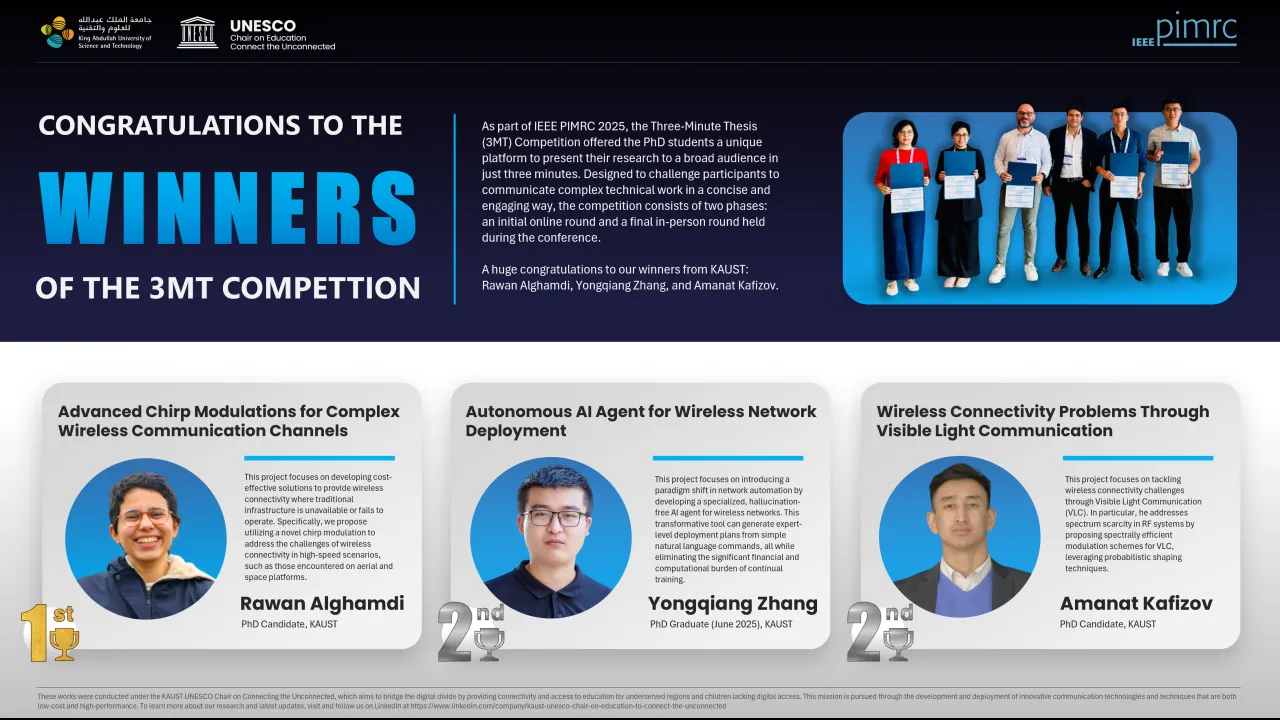
Top honors for KAUST students at IEEE PIMRC 2025
About
Rawan Alghamdi, Yongqiang Zhang, and Amanat Kafizov earned top honors in the Three-Minute Thesis (3MT) competition at the 2025 IEEE International Symposium on Personal, Indoor, and Mobile Radio Communications (PIMRC). Established in 1989 as a workshop in London, PIMRC has since grown into one of the two flagship conferences of the IEEE Communications Society (ComSoc) in wireless communications and networking, attracting participants from across the globe. The 3MT competition challenges PhD students to present their research ideas and technical contributions to a broad audience in just three minutes.
Rawan Alghamdi (PhD Candidate at KAUST won first place for her project titled "Advanced Chirp Modulations for Complex Wireless Communication Channels", done under the co-supervision of Prof. Mohamed-Slim Alouini and Prof. Tareq Al-Naffouri and in collaboration with Prof. Mohamed Siala (Sup-Com Tunis, Tunisia). Yongqiang Zhang and Amanat Kafizov both earned second place for their projects "Autonomous AI Agent for Wireless Network Deployment" and "Wireless Connectivity Problems through Visible Light Communication," respectively. Yongqiang worked under the supervision of Prof. Mohamed-Slim Alouini and in collaboration with Prof. Mustafa Kishk (Maynooth University, Ireland), defended his PhD at KAUST in June 2025, and is now a Postdoctoral Fellow at NYU Abu Dhabi under the supervision of Prof. Qurrat-Ul-Ain Nadeem. Finally, Amanat is a PhD candidate at KAUST working under the supervision of Prof. Mohamed-Slim Alouini and in collaboration with Prof. Ahmed Elzanaty (University of Surrey, UK).
The competition, held in Istanbul, Türkiye, on September 3, 2025, emphasized clear communication, engagement, and the ability to convey complex research in a concise and accessible manner. The winners were announced the following day at the IEEE PIMRC awards ceremony.
A Rigorous and Competitive Selection Process
The IEEE PIMRC 3MT Competition featured a multi-stage evaluation process that rigorously assessed participants on their comprehension, content clarity, engagement, and presentation skills. Competitors were challenged to present a compelling story about their thesis and the significance of their research in just three minutes, in language suitable for a non-specialist audience.
This year’s competition attracted 30 PhD candidates from leading global institutions. In Round 1, participants submitted pre-recorded presentations, which were evaluated anonymously by an expert panel. Only the top 5 entries were invited to Round 2, where finalists delivered their presentations live at IEEE PIMRC 2025 in Istanbul, Türkiye. The Round 2 presentations were evaluated by a committee of five experts in the field, comprising academics and industry professionals. Given the competitive field, the strong showing by KAUST researchers, securing both first prize and two second prizes, highlights their great ability to communicate cutting-edge research effectively.
Pushing the Boundaries of Communication Technology
The awarded presentations from KAUST covered a range of emerging research topics. Rawan’s project explored an innovative modulation technique to address the challenges of high-mobility wireless communication channels. Yongqiang’s work developed a hallucination-free AI agent for wireless networks that can generate expert-level deployment plans from natural language, with zero continual-training cost. Finally, Amanat’s research focuses on tackling wireless connectivity challenges through Visible Light Communication (VLC). In particular, he addresses spectrum scarcity in RF systems by proposing spectrally efficient modulation schemes for VLC, leveraging probabilistic shaping techniques.
A Platform for Recognizing Research Excellence
Participation in the 3MT competition not only highlighted the technical depth and communication skills of KAUST PhD students but also offered a unique platform to engage with a global audience and build collaborative bridges with fellow scholars. The videos of Rawan, Yongqiang, and Amanat are available on YouTube. Their ability to communicate complex ideas in a simple yet non-trivial way that the general public can understand showcases their commitment to engage with wider subsets of society and join the global movement of connecting the remaining 2.8 billion people worldwide. Their achievements also align with the broader vision of the KAUST UNESCO Chair, focusing on “Connecting the Unconnected,” which aims to develop communication technologies for underserved and remote environments, ensuring inclusive access to information, education, and opportunity across the globe.